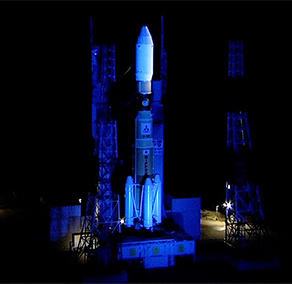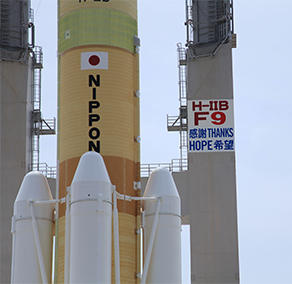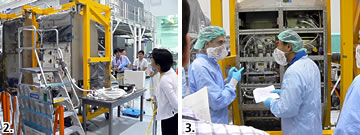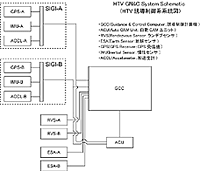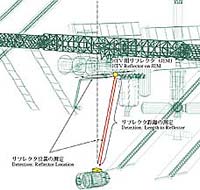Topics List
May 21, 2020 Updated
Successful Launch of the H-II Transfer Vehicle "KOUNOTORI9" aboard H-IIB Launch Vehicle No. 9
|
At exactly 31 minutes and 00 seconds past 2 o’clock on the morning of May 21, 2020, the H-II Transfer Vehicle known as "KOUNOTORI9" (HTV9), the cargo transporter to the International Space Station (ISS), was launched aboard H-IIB Launch Vehicle No. 9 (H-IIB F9) from the JAXA Tanegashima Space Center. We express our sincere appreciation for all the frontline workers fighting coronavirus (COVID-19), the people in the Tanegashima Island, and all of you supporting for this launch.
|
Sep. 25, 2019 Updated
KOUNOTORI8/H-IIB F8 Successfully Launched
|
The H-IIB Launch Vehicle No. 8 with cargo transporter to the International Space Station, the KOUNOTORI8 (HTV8) aboard lifted off from the Tanegashima Space Center at 1:05:05 on September 25. (Japan Standard Time) |
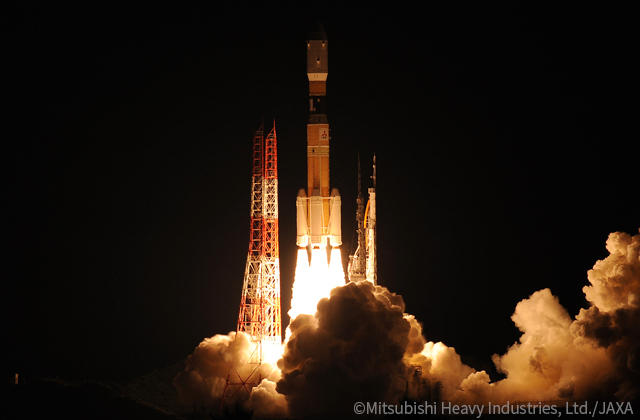
|
|---|
Nov. 19, 2018 Updated
The HTV7 Return Capsule Brought to the JAXA Tsukuba Space Center
|
At approximately 4 pm, January 17, the HTV7 return capsule was delivered to the JAXA Tsukuba Space Center. |

|
|---|
Nov. 13, 2018 Updated
Test Equipment in the HTV7 Return Capsule at the JAXA Tsukuba Space Center
|
At 9:42 am Today, Tuesday November 13, the sample collection capsule onboard the cargo transporter Kounotori (HTV7) was delivered to the JAXA Tsukuba Space Center. 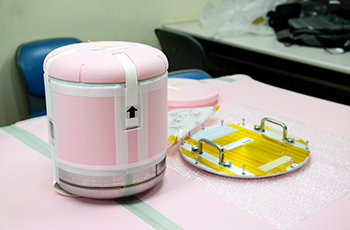
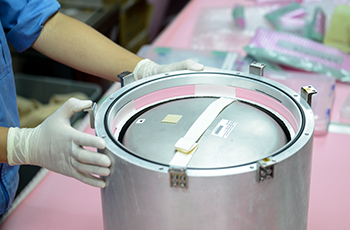
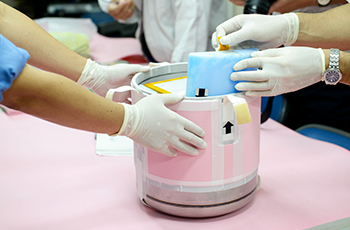
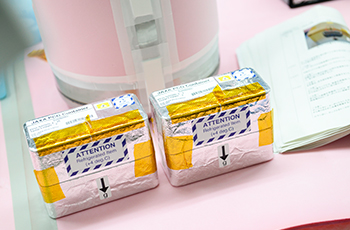
|
Nov. 12, 2018 Updated
The HSRC Recovered from the Ocean
|
At 7:06 am, Sunday November 11, the HTV Small Re-entry Capsule (HSRC) splashed down. 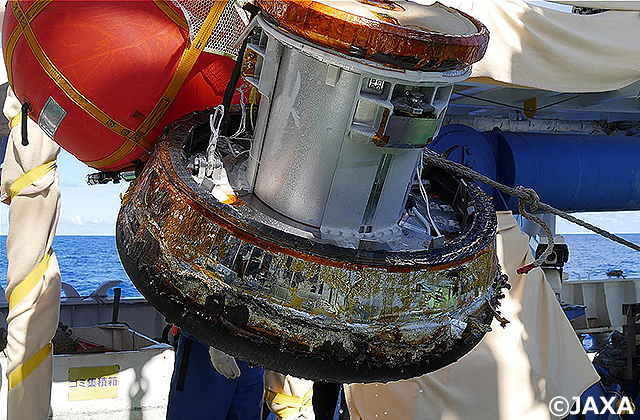 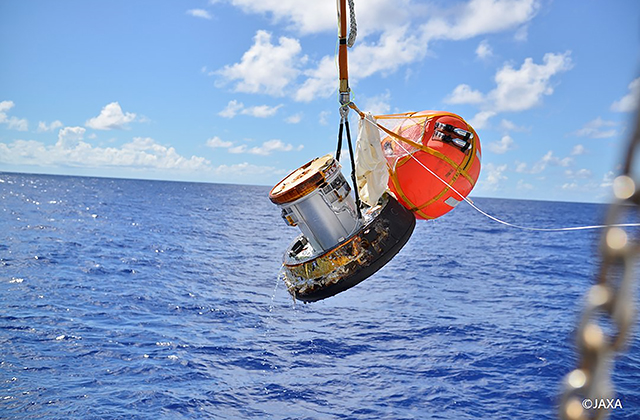
|
Nov. 8, 2018 Updated
HTV7 Departs from ISS
|
Alexander Gerst used the robotic arm to release the HTV transfer vehicle-7 (HTV7) at 1:50 am, November 8. Robotics ground controllers used the Station Remote Manipulator System (SSRMS) to unberth the HTV7 from the international outpost of the International Space Station. (ISS) HTV7’s thrusters were fired to move the spacecraft a safe distance from the station. |
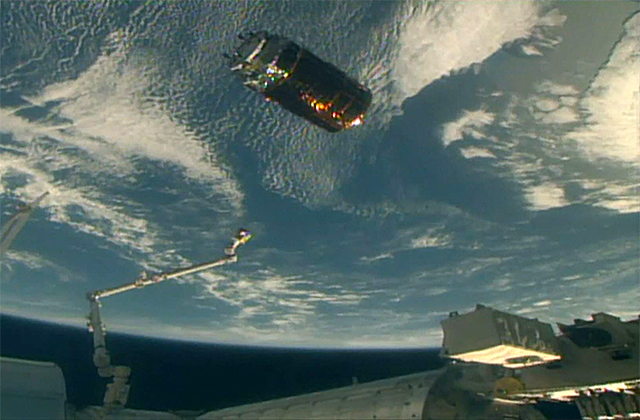
|
|---|
Nov. 7, 2018 Updated
HTV7 Set for Departure from ISS
|
The HTV Small Re-entry Capsule (HSRC) with experiment samples on board was attached onto the hatch of the pressurized logistic carrier of the HTV transfer vehicle-7 (HTV7) at 0:26 am, November 7, the process readying the HTV7 to unberth from the International Space Station. (ISS) JAXA Astronaut Takuya Onishi was among the ground controllers who gave commands from the JAXA Tsukuba Space Center. Onishi rejoiced together with the ground control teams of Kibo and HTV that this phase of the HTV7 mission was now completed. JAXA will cover the HTV7 departure from the ISS live from 1:20 am, November 8. Share the moments with us. 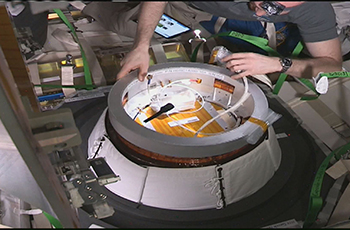
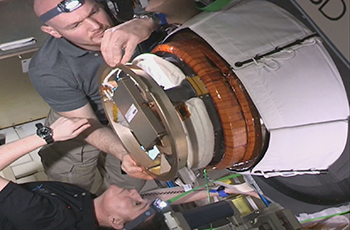
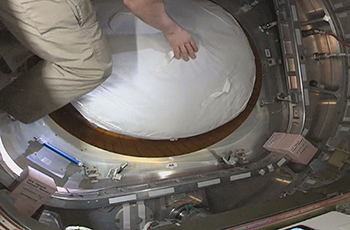
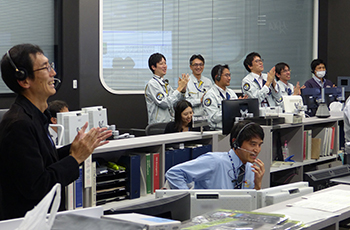
|
Sep. 28, 2018 Updated
KOUNOTORI7 berthed at ISS!
|
The cargo transporter to the International Space Station, KOUNOTORI7 (HTV7) was captured with the robotic arm of the International Space Station (ISS) at 20:36 p.m. on September 27 (Japan Standard Time) and berthed to the ISS at 3:08 a.m. on September 28 (JST). |
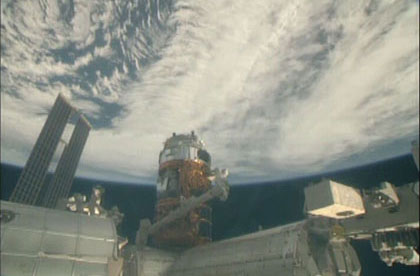
|
|---|
Sep. 23, 2018 Updated
KOUNOTORI7/H-IIB F7 Successfully Launched
|
The H-IIB Launch Vehicle No. 7 with cargo transporter to the International Space Station, the KOUNOTORI7 (HTV7) aboard lifted off from the Tanegashima Space Center at 2:54:27 on September 23. (Japan Standard Time) |
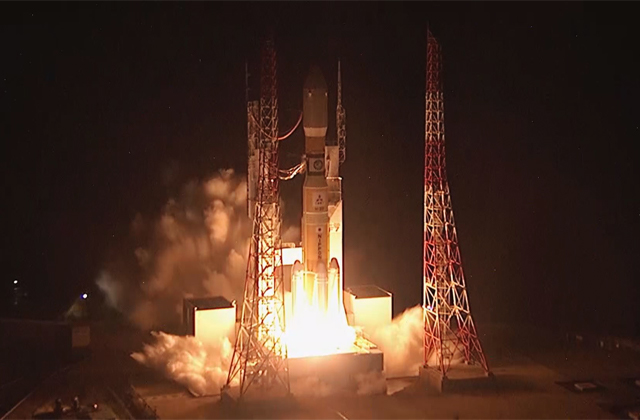
|
|---|
Sep. 21, 2018 Updated
KOUNOTORI7/H-IIB F7 launch time decided! Live broadcast from 2:27 a.m. on September 23 (Sun.)
|
The launch time of the H-IIB Launch Vehicle No. 7 with the KOUNOTORI7 (HTV7, a cargo transporter to the International Space Station) was set for 2:52:27 a.m. on September 23 (Sun.), 2018 (Japan Standard Time.) |
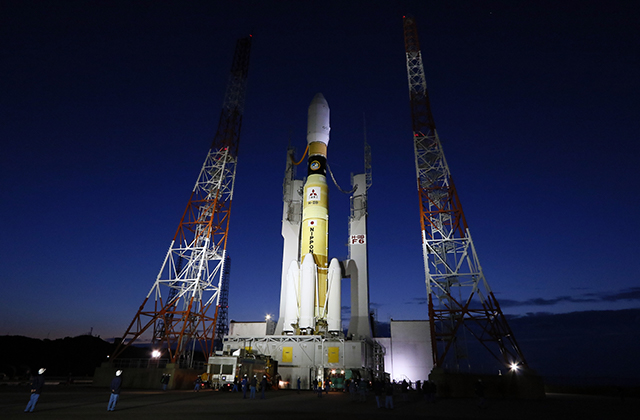
|
|---|
Sep. 15, 2018 Updated
Today's Launch Cancellation, H-II Transfer Vehicle "KOUNOTORI7" (HTV7)aboard the H-IIB Vehicle No.7
|
Today's Launch Cancellation, H-II Transfer Vehicle "KOUNOTORI7" (HTV7)aboard the H-IIB Vehicle No.7
Mitsubishi Heavy Industries, Ltd. and JAXA have cancelled launch of the H-IIB Launch Vehicle No. 7 (H-IIB F7) with aboard the H-II Transfer Vehicle "KOUNOTORI7" (HTV7), the cargo transporter to the International Space Station(ISS). The cancellation is because additional investigation became necessary of the H-IIB F7 propulsion system. The launch was scheduled for September 15 (Sat.), 2018, from the JAXA Tanegashima Space Center. |
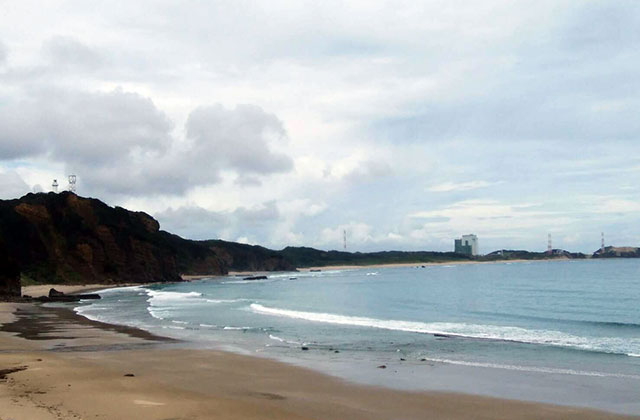
|
|---|
Sep. 13, 2018 Updated
KOUNOTORI7/H-IIB F7 launch time decided! Live broadcast from 5:35 a.m. on September 15 (Sat.)
|
The launch time of the H-IIB Launch Vehicle No. 7 with the KOUNOTORI7 (HTV7, a cargo transporter to the International Space Station) was set for 5:59:14 a.m. on September 15 (Sat.), 2018 (Japan Standard Time.) JAXA will broadcast a live launch report from the Tanegashima Space Center from 5:35 a.m. on the day. You can watch it through the Internet. Please have a look! |

|
|---|
Sep. 12, 2018 Updated
KOUNOTORI7 launch postponed to Sep. 15 (Sat., JST)
|
The launch date of the H-IIB Launch Vehicle No. 7 carrying the KOUNOTORI7 has been postponed as unfavorable weather is forecasted. The launch was originally scheduled for September 14, 2018. |

|
|---|
Sep. 11, 2018 Updated
KOUNOTORI7 launch rescheduled to around 6:20 a.m. on September 14 (Feb.) 2018
|
The KOUNOTORI7 (HTV7) / H-IIB F7 launch was postponed to around 6:20 a.m. on September 14 due to adverse weather. |

|
|---|
Sep. 9, 2018 Updated
KOUNOTORI7 launch postponed to Sep. 11 (Tue., JST)
|
The launch date of the H-IIB Launch Vehicle No. 7 carrying the KOUNOTORI7 has been postponed as unfavorable weather is forecasted. The launch was originally scheduled for September 11. The live broadcast of the launch will also be put off accordingly. |

|
|---|
Jul. 13, 2018 Updated
Launch day set for KOUNOTORI7/H-IIB F7!
|
The launch date and time for the H-IIB Launch Vehicle No. 7(H-IIB F7) with the H-II Transfer Vehicle "KOUNOTORI7" (HTV7) onboard was set for around 7:32 a.m. on September 11 (Tue.), 2018 (Japan Standard Time). |
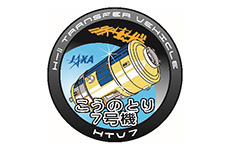
|
|---|
Feb. 6, 2017 Updated
KOUNOTORI6 completed its mission with re-entry!
|
The KOUNOTORI6 (HTV6, a cargo transporter to the International Space Station) left the ISS on Jan. 28 and re-entered the atmosphere at around 0:06 a.m. on Feb. 6 (Japan Standard Time.) |

|
|---|
Dec. 13, 2016 Updated
KOUNOTORI6 berthed at ISS!
|
The cargo transporter to the International Space Station, KOUNOTORI6 (HTV6) was captured with the robotic arm of the International Space Station (ISS) at 7:39 p.m. on December 13 (Japan Standard Time) and berthed to the ISS at 3:24 a.m. on December 14 (JST). The KOUNOTORI6 was launched by the H-IIB Launch Vehicle No.6 on December 9. |

|
|---|
Dec. 10, 2016 Updated
KOUNOTORI6/H-IIB F6 Successfully Launched
|
The H-IIB Launch Vehicle No. 6 with cargo transporter to the International Space Station, the KOUNOTORI6 (HTV6) aboard lifted off from the Tanegashima Space Center at 22:26:47 on December 9. (Japan Standard Time) |
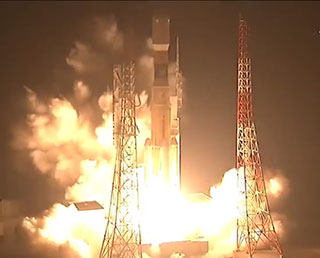
|
|---|
Dec. 8, 2016 Updated
KOUNOTORI6/H-IIB F6 launch time decided! Live broadcast from 9:35 p.m. on December 9 (Fri.)
|
The launch time of the H-IIB Launch Vehicle No. 6 with the KOUNOTORI6 (HTV6, a cargo transporter to the International Space Station) was set for 10:26:47 p.m. on December 9 (Fri.), 2016 (Japan Standard Time.) |

|
|---|
Oct. 19, 2016 Updated
KOUNOTORI6 (HTV6) Makes Debut to Media
|
On October 19, members of the media were invited to view KOUNOTORI6 (HTV6), H-II transfer vehicle to the Space Station. The event was held at Tanegashima Space Center (TNSC) and attracted many as it showed actual HTV6 before launch. |
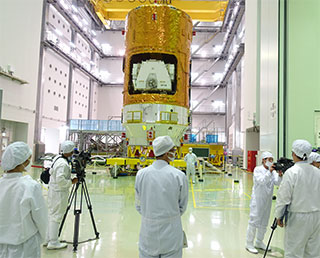
|
|---|
Oct. 7, 2016 Updated
Launch Schedule of “KOUNOTORI6” (HTV6) Updated to December 9
|
The launch schedule of the H-IIB Launch Vehicle No. 6 with the H-II Transfer Vehicle “KOUNOTORI6” (HTV6) on board, temporarily postponed has been updated to around 10:26 p.m. on December 9 (Fri.), (Japan Standard Time, JST). |
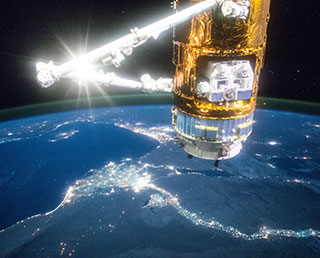
|
|---|
Aug. 10, 2016 Updated
Launch Postponement of “KOUNOTORI6” (HTV6)
|
Mitsubishi Heavy Industries, Ltd. and JAXA decided to postpone the launch of the H-IIB Launch Vehicle No. 6 with “KOUNOTORI6” (HTV6) onboard which was scheduled for October 1 (Sat.), 2016 (Japan Standard Time), as unfavorable.
|
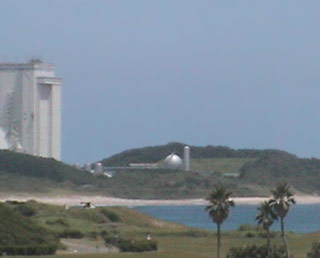
|
|---|
Jul. 26, 2016 Updated
Launch day set for KOUNOTORI6/H-IIB F6!
|
The launch date and time for the H-IIB Launch Vehicle No. 6 (H-IIB F6) with the H-II Transfer Vehicle "KOUNOTORI6" (HTV6) onboard was set for around 2:16 a.m. on October 1 (Sat.), 2016 (Japan Standard Time). |
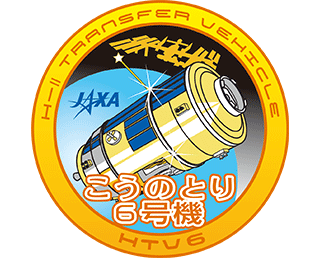
|
|---|
Sep. 30, 2015 Updated
KOUNOTORI5 completed its mission with re-entry!
|
The KOUNOTORI5 (HTV5, a cargo transporter to the International Space Station) left the ISS on Sept. 29 and re-entered the atmosphere at around 5:33 a.m. on Sept. 30 (Japan Standard Time.) |
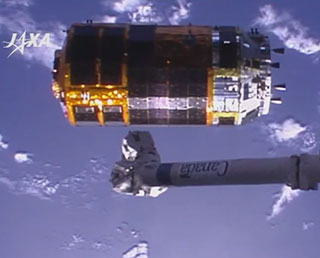
|
|---|
Sep. 16, 2015 Updated
Live Internet broadcast of KOUNOTORI5’s departure from ISS on Sept. 28 (Mon.)
|
The KOUNOTORI5 will leave the International Space Station (ISS) at 0:20 a.m. on September 29 (Tue.), and re-enter the Earth's atmosphere at around 5:31 a.m. on the 30th (Wed.) to burn up. JAXA will broadcast the live report of its separation from the ISS through the Internet from around 11:50 p.m. on Sept. 28 (Mon.). Please don’t miss it! (All dates and time are Japan Standard Time.) (Photo: JAXA/NASA) |
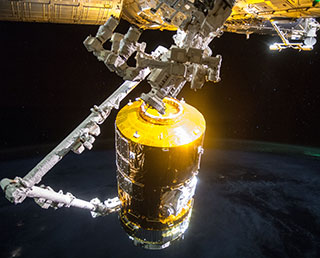
|
|---|
Aug. 25, 2015 Updated
KOUNOTORI5 captured and berthed at the ISS
|
The “KOUNOTORI5” launched by the H-IIB F5 on Aug. 19 (Wed. Japan Standard Time) was captured by the robotic arm of the International
Space Station (ISS), which was maneuvered by Astronaut Kimiya Yui, at 7:29 p.m. on August 24 (Mon. JST). The HTV5 was then successfully
berthed at the ISS at 2:28 a.m. on August 25 (Tue. JST). |
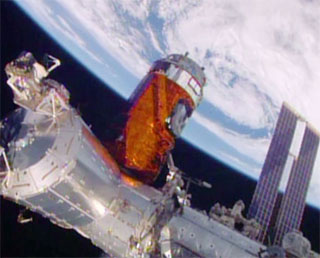
|
|---|
Aug. 19, 2015 Updated
KOUNOTORI5 successfully launched by H-IIB F5!
|
The KOUNOTORI5, a regular cargo transporter to space, was launched by the H-IIB Launch Vehicle No.5 (H-IIB F5) at 8:50:49 p.m. on August 19 (Wed.) 2015 (Japan Standard Time, JST) from the Tanegashima Space Center. The launch vehicle flew smoothly, and, at about 14 minutes and 54 seconds after liftoff, the separation of the KOUNOTORI5 was confirmed. |
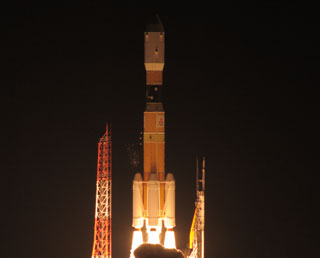
|
|---|
Aug. 17, 2015 Updated
KOUNOTORI5 launch rescheduled to 8:50:49 p.m. on August 19 (Wed.) 2015
|
The KOUNOTORI5(HTV5)/H-IIB F5 launch was postponed to 8:50:49 p.m. on August 19 due to adverse weather. |

|
|---|
Aug. 16, 2015 Updated
KOUNOTORI5 launch postponed to Aug. 19 (Wed., JST)
|
The launch date of the H-IIB Launch Vehicle No. 5 carrying the KOUNOTORI5 has been postponed as unfavorable weather is forecasted. The
launch was originally scheduled for August 17. The live broadcast of the launch will also be put off accordingly. |

|
|---|
Aug. 15, 2015 Updated
New launch date and time of KOUNOTORI5/H-IIB F5 decided
|
The KOUNOTORI5/H-IIB F5 launch was postponed to 9:35:54 p.m. on August
17 due to adverse weather. The launch was originally scheduled for
August 16.. |
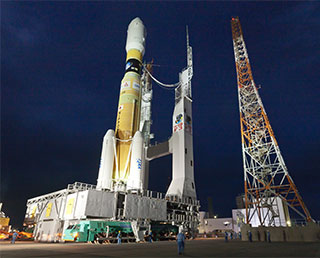
|
|---|
Aug. 14, 2015 Updated
KOUNOTORI5 launch postponed to Aug. 17 (Mon., JST)
|
The launch date of the H-IIB Launch Vehicle No. 5 carrying the KOUNOTORI5 has been postponed as unfavorable weather is forecasted. The
launch was originally scheduled for August 16. The live broadcast of the launch will also be put off accordingly. |

|
|---|
Jul. 21, 2015 Updated
Dates set for capturing the KOUNOTORI5 and its berthing with ISS Astronaut Yui to be in charge of operation
|
After international coordination, the dates for capturing the KOUNOTORI5, a cargo transporter to the International Space Station (ISS), and its berthing have been respectively set as August 20 (Thu.) and 21 (Fri.) The KOUNOTORI5 is scheduled to be launched on August 16 (Sun.) from the Tahegashima Space Center. |
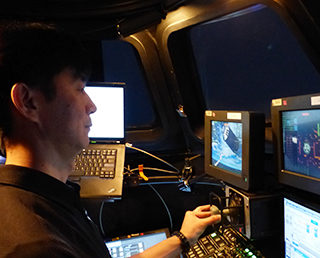
|
|---|
Jul. 10, 2015 Updated
KOUNOTORI5 and operation simulation training opened to the press
|
On July 1, the KOUNOTORI5, a cargo transporter to the ISS, was revealed to the media at the Tanegashima Space Center. The mission was also explained there. |
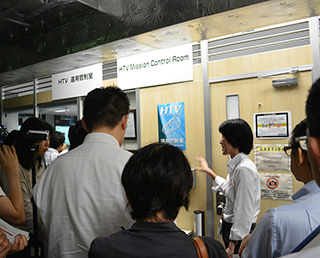
|
|---|
Jun. 9, 2015 Updated
Launch day set for KOUNOTORI5/H-IIB F5!
|
The launch date and time for the H-IIB Launch Vehicle No. 5 (H-IIB F5)
with the H-II Transfer Vehicle "KOUNOTORI5" (HTV5) onboard was set for
around 10:01 p.m. on August 16 (Sun.), 2015 (Japan Standard Time). |
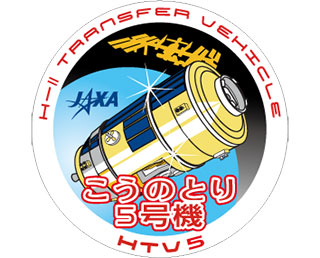
|
|---|
Sep. 7, 2013 Updated
KOUNOTORI4 completed its mission with re-entry!
|
The KOUNOTORI4 (HTV4, a cargo transporter to the International Space Station) left the ISS on Sept. 5 and re-entered the atmosphere at 3:37 p.m. on Sept. 7 (Japan Standard Time.) |
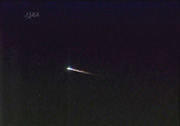
|
|---|
Sep. 3, 2013 Updated
Re-entry date and time for KOUNOTORI4 decided
|
Schedules of departure from the International Space Station (ISS) and of re-entry to the atmosphere for the H-II Transfer Vehicle “KOUNOTORI 4” (HTV4) are determined as follows. |
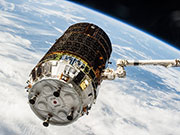 |
|---|
Aug. 10, 2013 Updated
KOUNOTORI4 berthed at ISS!
|
The KOUNOTORI4 (HTV4, a cargo transporter to the International Space Station) was captured by the ISS robotic arm at 8:22 p.m. on August 9 (Japan Standard Time) and berthed at the ISS at 3:38 a.m. on August 10 (JST). The KOUNOTORI4 was launched by the H-IIB Launch Vehicle No.4 on August 4. ISS astronauts will take cargo out from the Pressurized and Unpressurized Logistic Carriers into the ISS. |
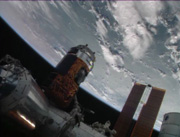 |
|---|
Aug. 9, 2013 Updated
Live broadcast of KOUNOTORI4 trip to ISS!
|
The KOUNOTORI3 (HTV4, the cargo transporter to the International Space Station) launched on August 4 has been traveling to the ISS while adjusting its altitude. Between the evening on August 9 and early on the morning of August 10, the KOUNOTORI4 will make a final approach and berth at the ISS. JAXA will provide a live broadcast of its final access, capture, and berthing. |
 |
|---|
Aug. 4, 2013 Updated
Launch Success of KOUNOTORI4/H-IIB F4
|
The H-IIB Launch Vehicle No. 4 with the KOUNOTORI4 (HTV4, a cargo transporter to the International Space Station) onboard lifted off from the Tanegashima Space Center at4:48:46 a.m. on August 4 (Sun., Japan Standard Time.) |
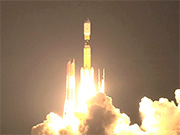 |
|---|
Jun. 19, 2013 Updated
KOUNOTORI4 revealed at TNSC
|
On June 19, the H-II Transfer Vehicle (HTV, a cargo transporter to the International Space Station) “KOUNOTORI4” was shown to the media at the Tanegashima Space Center (TNSC.) |
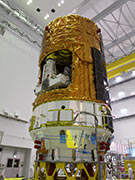 |
|---|
May 21, 2013 Updated
KOUNOTORI4/H-IIB F4 launch schedule decided!
|
The H-IIB Launch Vehicle No. 4 (H-IIB F4) carrying the H-II Transfer Vehicle (HTV4, a cargo transporter to the International Space Station) will be launched on August 4 (Sunday, Japan Standard Time.) The launch time will be around 4:48 a.m. (JST.) It will be blasted off from the Yoshinobu Launch Complex at the Tanegahsima Space Center. Why don't you take this opportunity to come to Tanegahima to witness the liftoff at hand! |
 |
|---|
Sep. 14, 2012 Updated
KOUNOTORI3 completed its mission with re-entry!
|
The KOUNOTORI3 (HTV3, a cargo transporter to the International Space Station) left the ISS on Sept. 13 and re-entered the atmosphere at 2:27 p.m. on Sept. 14 (Japan Standard Time.) |
 |
|---|
Sep. 11, 2012 Updated
KOUNOTORI3 departure and re-entry live report!
|
The H-II Transfer Vehicle “KOUNOTORI3” (HTV3,a cargo transporter to the International Space Station) will leave from the ISS at around 0:50 a.m. on Sept. 13 (Japan Standard Time, all the following dates and time are JST,) and will re-enter the atmosphere at around 2:24 p.m. on Sept. 14. |
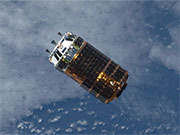 |
|---|
Sep. 7, 2012 Updated
Re-entry date and time for KOUNOTORI3 decided
|
The re-entry schedule for the KOUNOTORI3 was set as follows after extended mooring at the International Space Station due to an additional extravascular activity. |
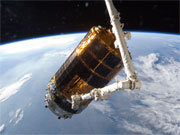 |
|---|
Jul. 28, 2012 Updated
KOUNOTORI3 berthed at ISS!
|
The KOUNOTORI3 (HTV3, a cargo transporter to the International Space Station) was captured by the ISS robotic arm at 9:23 p.m. on July 27 (Japan Standard Time) and berthed at the ISS at 2:31 a.m. on July 28. The KOUNOTORI3 was launched by the H-IIB Launch Vehicle No.3 on July 21. ISS astronauts will take cargo out from the Pressurized and Unpressurized Logistic Carriers into the ISS. |
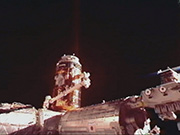 |
|---|
Jul. 21, 2012 Updated
Launch Success of KOUNOTORI3/H-IIB F3
|
The H-IIB Launch Vehicle No. 3 with the KOUNOTORI3 (HTV3, a cargo transporter to the International Space Station) onboard lifted off from the Tanegashima Space Center at 11:06:18 on July 21 (Sat., Japan Standard Time.) |
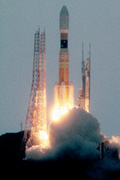 |
|---|
Jun. 21, 2012 Updated
KOUNOTORI3/H-IIB F3 Special Site now open!
|
JAXA will launch the KOUNOTORI3 (a cargo transporter to the International Space Station, ISS) by H-IIB Launch vehicle No.3 on July 21 from the Tanegashima Space Center. We have opened the KOUNOTORI3/H-IIB F3 Special Site to be ready for the launch. |
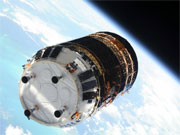 |
|---|
Jun. 7, 2012 Updated
KOUNOTORI3 revealed to the media at TNSC
|
On June 1 (Fri.), the H-II Transfer Vehicle "KOUNOTORI3" (HTV3, a cargo transporter to the International Space Station) was revealed to the media at the Spacecraft and Fairing Assembly Building 2 at the Tanegashima Space Center. The KOUNOTORI3 will be packed with food and daily necessities for astronauts aboard the ISS, test equipment for aquatic organisms, and other experiment devices including a small satellite, then will be launched by the H-IIB Launch Vehicle No. 3 at 11:18 a.m. on July 21, 2012 (Japan Standard Time.) The KOUNOTORI is currently under preparations for its journey to space. |
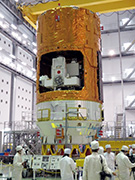 |
|---|
Mar. 21, 2012 Updated
KOUNOTORI3/H-IIB F3 launch schedule decided!
|
The launch date and time for the H-IIB Launch Vehicle No. 3 (H-IIB F3) with the H-II Transfer Vehicle "KOUNOTORI3" (HTV3), a cargo transporter to the International Space Station, has been set to be at around 11:18 a.m. on July 21 (Sat.), 2012 (Japan Standard Time.) The launch preparation operation for the KOUNOTORI is smoothly in progress at the Tanegashima Space Center. |
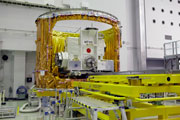 |
|---|
Mar. 30, 2011 Updated
KOUNOTORI2 re-entered the atmosphere to complete its mission!
|
The KOUNOTORI2 (HTV2, a cargo transporter to the International Space Station,) which left the ISS at around 0:46 a.m. on March 29 (Japan Standard Time,) re-entered the atmosphere at around 12:09 p.m. on March 30 (JST.) |
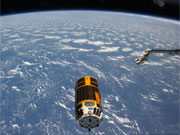 |
|---|
Mar. 29, 2011 Updated
KOUNOTORI2 left ISS!
|
The KOUNOTORI2 (HTV2, a cargo transporter to the ISS) was detached from the International Space Station (ISS) using the ISS robotic arm at 10:29 p.m. on March 28 (Japan Standard time,) and it emitted a jet to leave the ISS after being transported to the release point at 0:46 a.m. on the 30th. |
 |
|---|
Mar. 25, 2011 Updated
KOUNOTORI2 leaving ISS on the 29th! Live broadcast scheduled
|
The KOUNOTORI2 (HTV2, a cargo transporter to the International Space Station) will depart from the ISS with used material loaded on March 29 (Japan Standard Time,) and will be slated for re-entry to the atmosphere on the 30th (JST.) JAXA will broadcast a live Internet report of the KOUNOTORI departure from the ISS from 0:00 a.m. on the 29th (JST,) then its re-entry to the atmosphere from 11:30 a.m. on the 30th (JST.) Please watch the events through the Internet! |
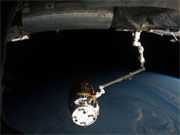 |
|---|
Mar. 22, 2011 Updated
KOUNOTORI2 to leave ISS
|
The departure date of the KOUNOTORI2 (HTV2, a cargo transporter to the ISS), which is loaded with used materials, from the International Space Station (ISS) has been decided. |
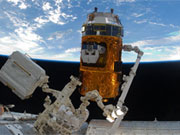 |
|---|
Mar. 11, 2011 Updated
KOUNOTORI2 relocation to the earth-facing port completed
|
At 8:49 p.m. on March 10 (Japan Standard Time), the KOUNOTORI2 (HTV2, a cargo transporter to the International Space Station) began to be moved from the zenith port to the earth-facing port using the robotic arm of the International Space Station. At 3:55 a.m. on the 11th (JST,) KOUNOTORI2's electric and communication systems were connected to the ISS to complete the relocation. After being loaded with used items, the KOUNOTORI2 will re-enter the atmosphere to be burned. |
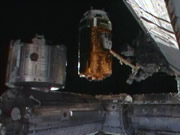 |
|---|
Mar. 9, 2011 Updated
KOUNOTORI2 to return to earth-facing port from March 10
|
The KOUNOTORI2 (HTV2, a cargo transporter to the International Space Station), will move back to the earth-facing port of the Harmony (Node 2) from its zenith port now that the Space Shuttle Discovery left the ISS to go home on March 7 (Japan Standard Time.) The relocation is scheduled to be performed on the 10th and 11th (JST.) More cargo will be taken out of the KOUNOTORI2, then, after being packed with used materials, the KOUNOTORI2 will re-enter the atmosphere. |
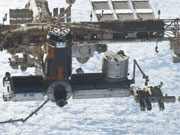 |
|---|
Feb. 21, 2011 Updated
KOUNOTORI2 relocation to the zenith port completed
|
As part of preparations for the Space Shuttle Discovery’ s docking with the International Space Station (ISS,) the KOUNOTORI2 , or the HTV2, a cargo transporter to the ISS, was moved from the earth-facing port of the Harmony (Node 2) to its zenith port. This was the first time to perform such a relocation. The KOUNOTORI2 was successfully transported at 1:45 a.m. on Feb. 19 (Japan Standard Time,) and the electric cables were connected with the Harmony at 4:26 a.m. (JST) to complete its relocation. |
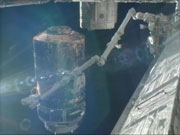 |
|---|
Jan. 28, 2011 Updated
KOUNOTORI2 berthing at ISS
|
The KOUNOTORI2, or the HTV2, a cargo transporter to the International Space Station (ISS) launched by the H-IIB Launch Vehicle No.2, was captured by the ISS robotic arm at around 8:41 p.m. on January 27 (Japan Standard Time,) and, at around 3:34 a.m. on the 28th (JST,) the KOUNOTORI berthed at the ISS. Cargo in the Pressurized Section will be transported to the ISS by the ISS astronauts followed by cargo in unpressurized areas. |
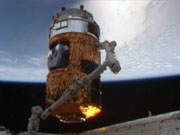 |
|---|
Jan. 22, 2011 Updated
KOUNOTORI2/H-IIB F2 successfully launched
|
The H-IIB Launch Vehicle No. 2 with the KOUNOTORI2 (HTV2, a cargo transporter to the International Space Station, ISS) onboard was launched from the Tanegashima Space Center at 2:37:57 p.m. on January 22 (Sat., Japan Standard Time.) The launch vehicle flew smoothly, and, at about 15 minutes and 13 seconds after liftoff, the separation of the KOUNOTORI2 was confirmed. |
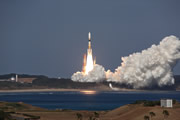 |
|---|
Dec. 14, 2010 Updated
KOUNOTORI2 system checkup completed
|
At the Tanegashima Space Center, all parts of the H-II Transfer Vehicle “KOUNOTORI2” (HTV2) were integrated electrically and mechanically in the end of October. Throughout November, the assembled KOUNOTORI2 has been checked as one system to confirm that no problem was found in the vehicle. |
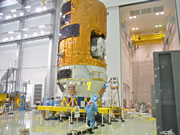 |
|---|
Dec. 1, 2010 Updated
KOUNOTORI2 control and operation simulation revealed to the press
|
On November 30, JAXA showed part of the control and operation simulation of the KOUNOTORI2 to the media at the Tsukuba Space Center. The KOUNOTORI2 (HTV2) is a cargo transfer vehicle to the International Space Station (ISS.) |
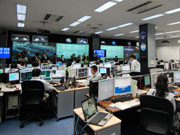 |
|---|
Nov. 26, 2010 Updated
KOUNOTORI2 shown to the Press at TNSC
|
On Nov. 25, the H-II Transfer Vehicle “KOUNOTORI”2 (a cargo transporter to the International Space Station) was revealed to the media at the Spacecraft and Fairing Assembly Building No. 2 at the Tanegashima Space Center. We are engaging in preparation for the launch of the KOUNOTORI2 including propellant loading and mating with the launch vehicle. |
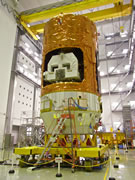 |
|---|
Nov. 11, 2010 Updated
HTV nickname selected & special site open!
|
"KOUNOTORI" (meaning "a white stork" in English) was chosen as the nickname of the H-II Transfer Vehicle (HTV, a cargo transfer vehicle to the International Space Station.) |
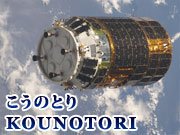 |
|---|
Nov. 10, 2010 Updated
Launch day set for HTV2/H-IIB F2!
|
The launch date and time for the H-IIB Launch Vehicle No. 2 (H-IIB F2) with the H-II Transfer Vehicle (HTV2) onboard was set for around 3:29 p.m. on January 20 (Thu.), 2011 (Japan Standard Time). The HTV2 is a cargo transporter to the International Space Station (ISS.) The integration of all modules of the HTV2 was completed at the Tanegashima Space Center (TNSC), and it will enter the final launch preparation phase. The H-IIB F2 has already been transported to the TNSC, and it is now being assembled there. |
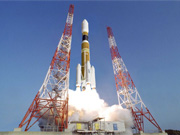 |
|---|
Nov. 2, 2010 Updated
HTV2: all modules connected, moved to final launch preparations
|
|
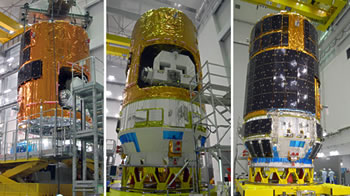 |
|---|
Oct. 13, 2010 Updated
Full assembly started for the second HTV
|
The assembly operation for all modules of the second H-II Transfer Vehicle (HTV, the cargo transporter to the International Space Station) started on October 6 at the second Spacecraft and Fairing Assembly Building (SFA2) at the Tanegashima Space Center. Prior to full assembly, in mid September, cargo to the ISS was loaded onto the Pressurized and Unpressurized Carriers. |
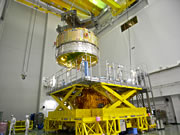 |
|---|
Apr. 7, 2010 Updated
Development of HTV/H-IIB received Japan industry technology/MEXT award
|
JAXA was selected as one of 12 organizations to receive the Ministry of Education, Culture, Sports, Science and Technology award at the 39th Japan industry technology awards for its development of the HTV and H-IIB launch vehicle. |
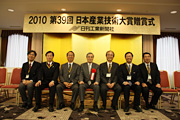 |
|---|
Feb. 10, 2010 Updated
HTV Project Team awarded for research
|
Since 2005, the National Institute of Science Technology Policy (NISTEP) of the Ministry of Education, Culture, Sports, Science and Technology (MEXT) has been choosing researchers who have made significant contributions to science and technology every year to praise their efforts. In 2009, the demonstration flight of the H-II Transfer Vehicle (HTV, a cargo transporter to the International Space Station) was highly evaluated, and on February 9, Mr. Torano, HTV Project Manager, Mr. Koyari, Sub-project Manager, and Mr. Sasaki, Functional Manager, received a memento of the selection. |
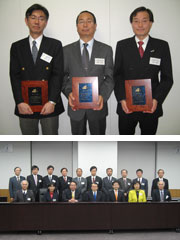 |
|---|
Nov. 2, 2009 Updated
HTV re-entered the atmosphere, mission completed
|
The H-II Transfer Vehicle (HTV) Demonstration Flight, which departed from the International Space Station (ISS) on October 31, re-entered the atmosphere at around 6:26 a.m. on November 2. |
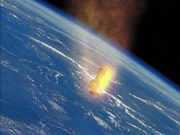 |
|---|
Oct. 31, 2009 Updated
HTV released from ISS
|
The H-II Transfer Vehicle (HTV) Demonstration Flight, which completed its cargo transportation mission at the International Space Station (ISS), was unberthed from the ISS by its robotic arm (SSRMS) at 0:02 a.m. on October 31 (Japan Standard Time, the following dates and times are JST.) The HTV departed from the ISS at 2:32 a.m. on the 31st. The HTV will leave the ISS orbit, and is scheduled to re-enter the Earth's atmosphere at around 6:25 a.m. on November 2 (Mon.) |
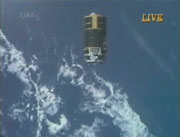 |
|---|
Oct. 27, 2009 Updated
Internet Live Report: HTV leaving ISS on Oct. 31 (Sat)
|
The H-II Transfer Vehicle (HTV) Demonstration Flight, which is currently berthed at the International Space Station (ISS), is scheduled to depart from the ISS at 2:30 a.m. on Oct. 31 (Sat) (Japan Standard Time, all the following days and times are in JST.) The HTV will be unberthed from the ISS by the ISS robotic arm (SSRMS) late at night on Oct. 30 (Fri) after its hatch to the ISS is closed at dawn of Oct. 30, then depart from the ISS. If everything goes smoothly, the HTV will re-enter the Earth's atmosphere around 6:25 a.m. on Nov. 2 (Mon). |
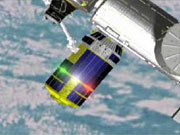 |
|---|
Oct. 21, 2009 Updated
The HTV PLC unloading operations completed, trash loading continues
|
HTV-1, being berthed to the ISS, is operating nominally. The Small Fine Arm (SFA) of the Kibo Remote Manipulator System (JEMRMS), packed in a Cargo Transfer Bag (CTB) and delivered to the ISS, was transferred from the HTV Pressurized Logistics Carrier (PLC) to Kibo on October 4. The Pressurized Stowage Resupply Rack (PSRR), also delivered on the HTV-1, was transferred to Kibo’s Experiment Logistics Module-Pressurized Section (ELM-PS) on October 14. All the cargo transfer operation from the HTV PLC to the ISS was completed on October 20. |
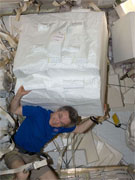 |
|---|
Oct. 14, 2009 Updated
HTV operations running smoothly, cargo unloading continues
|
Cargo unloading operations continued from the Pressurized Logistics Carrier of the H-II Transfer Vehicle (HTV) Demonstration Flight berthed at the International Space Station (ISS). On Oct. 4, the Small Fine Arm (SFA) of the Kibo’s Robotic Arm was moved to the ISS. The SFA was transported to the ISS as it was still packed in the Cargo Transfer Bag. One unit of the Pressurized Stowage Resupply Rack will be transferred to the ISS on the 14th. |
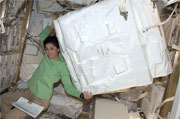 |
|---|
Sep. 26, 2009 Updated
Exposed Pallet stored back in HTV
|
The Exposed Pallet of the H-II Transfer Vehicle (HTV) Demonstration Flight was retrieved and stored back in the HTV Unpressurized Carrier at 10:20 p.m. on Sept. 25 (Japan Standard Time) by the robotic arms of the Kibo and the International Space Station (SSRMS) after its two cargoes, the experiment devices in the unpressurized environment, had been installed in the Kibo’s Exposed Facility. |
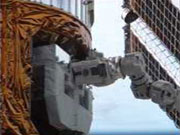 |
|---|
Sep. 25, 2009 Updated
Two experiment devices installed onto Kibo Exposed Facility
|
On Sept. 24 and 25 (Japan Standard Time), two experiment devices that were shipped by the H-II Transfer Vehicle (HTV) Demonstration Flight were unloaded from the HTV Exposed Pallet and installed onto the Exposed Facility of the Japanese Experiment Module “Kibo.” |
 |
|---|
Sep. 24, 2009 Updated
HTV Exposed Pallet attached to the Kibo Exposed Facility
|
At 6:06 p.m. on Sept. 23rd (Japan Standard Time, JST), the Exposed Pallet was taken out from the H-II Transfer Vehicle (HTV) Demonstration Flight, which is now berthed at the International Space Station (ISS). The Pallet was then attached onto the Exposed Facility of the Japanese Experiment Module “Kibo” at 11:33 p.m. (JST). The experiment devices on the Pallet will be moved to be installed onto the Kibo’s Exposed Facility. (Photo by NASA) |
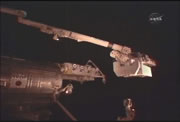 |
|---|
Sep. 18, 2009 Updated
HTV Demonstration Flight successfully berthed at ISS
|
The H-II Transfer Vehicle (HTV) Demonstration Flight, launched by the H-IIB Launch Vehicle Test Flight at 2:01 a.m. on Sept. 11 (Japan Standard Time, JST,) took almost one week to approach the International Space Station (ISS) and arrived at the Berthing Point 10 meters below the ISS at 4:27 a.m. on the 18th (JST, following times are all JST.) At 4:51 a.m., the HTV was captured by the ISS robotic arm (Space Station Remote Manipulator System, SSRMS) manipulated by the ISS crew, and it was installed onto the Common Berthing Mechanism (CBM) on the lower side (earth side) of the Harmony (Node 2) at 7:26 a.m. At 10:49 a.m., electric and communication lines were connected, and the HTV was successfully berthed at the ISS. |
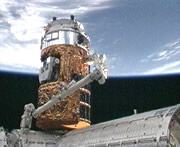 |
|---|
Sep. 15, 2009 Updated
Live reports of the HTV final approach to the ISS on Sept. 18 (Fri.)
|
The H-II Transfer Vehicle (HTV) Demonstration Flight, which was launched by the H-IIB Launch Vehicle at 2:01:46 a.m. on September 11 (Fri.) has been smoothly flying on its scheduled course. Its final approach to the International Space Station (ISS) was approved at the ISS Mission Management Team (IMMT) meeting on Sept. 15, thus, from the 16th, the altitude of the HTV will be maneuvered to gradually approach the ISS. The HTV is scheduled to be berthed at the ISS on Sept. 18 (Fri.) |
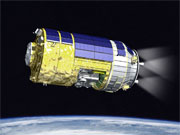 |
|---|
Sep. 11, 2009 Updated
HTV/H-IIB Successfully Launched!!
|
The Japan Aerospace Exploration Agency (JAXA) launched the H-II Transfer Vehicle (HTV) Demonstration Flight aboard the H-IIB Launch Vehicle Test Flight (H-IIB TF1) at 2:01:46 a.m. on September 11, 2009 (Japan Standard Time, JST) from the Tanegashima Space Center. The launch vehicle flew smoothly, and, at about 15 minutes and 6 seconds after liftoff, the separation of the HTV Demonstration Flight was confirmed. |
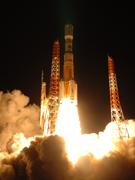 |
|---|
Aug. 31, 2009 Updated
HTV moved to the VAB! Final launch preparation phase
|
On August 30, the encapsulated HTV Demonstration Flight was transported to the Vehicle Assembly Building (VAB.) It will be loaded onto the H-IIB Launch Vehicle to be ready for the launch on September 11. We published a promotion movie of the HTV/H-IIB mission. Please watch it before witnessing the actual launch! |
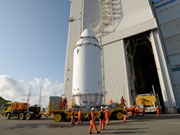 |
|---|
Aug. 24, 2009 Updated
HTV encapsulated
|
On August 21, the H-II Transfer Vehicle (HTV) Demonstration Flight was mated with the Payload Attach Fitting (PAF) at the Spacecraft and Fairing Assembly Building #2. |
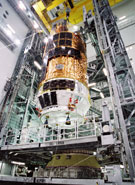 |
|---|
Jul. 9, 2009 Updated
HTV opened to the press at TNSC
|
On July 9, the H-II Transfer Vehicle (HTV, a cargo transporter to the International Space Station) was opened to the press at the Spacecraft and Fairing Assembly Building #2 (SFA2) at the Tanegashima Space Center (TNSC.) |
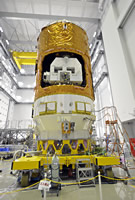 |
|---|
Jul. 8, 2009 Updated
HTV/H-IIB launch date decided! Special site opened
|
The H-IIB Launch Vehicle Test Flight with the H-II Transfer Vehicle (HTV, a cargo transporter to the International Space Station) will be launched at 2:04 a.m. on September 11 (Fri.). (*) |
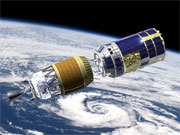 |
|---|
Jun. 30, 2009 Updated
Preparations for the HTV Demonstration Flight going smoothly at TNSC
|
Preparations for the Demonstration Flight of the H-II Transfer Vehicle (HTV) are underway at the Tanegashima Space Center (TNSC). |
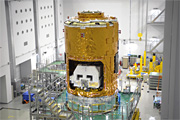 |
|---|
Apr. 24, 2009 Updated
HTV arrives at TNSC
|
At dawn on April 23, the First H-II Transfer Vehicle (HTV) was transported from Shimama Port at Tanegashima to the Tanegashima Space Center (TNSC.) The HTV left the Tsukuba Space Center on April 17. The Pressurized Logistic Carrier, Unpressurized Logistic Carrier, the Avionics Module, and the Propulsion Module were detached for the transportation, thus they will be assembled after arrival. A final functional checkup will be held prior to the launch. |
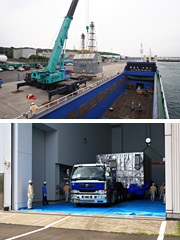 |
|---|
Apr. 17, 2009 Updated
HTV left for the TNSC
The first H-II Transfer Vehicle (HTV), or the HTV Technology Demonstrator, left the Tsukuba Space Center at dawn on April 17, 2009, for the Tanegashima Space Center (TNSC.) After arrival, the HTV will be assembled and checked for launch by the H-IIB Launch Vehicle, which is now under testing.
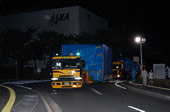
The first HTV leaving the TKSC (Unpressurized Logistics Carrier, Avionics Module, and Plopulsion Module)
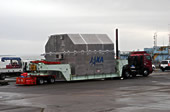
The first HTV arrived at Tsuchiura Port
(Unpressurized Logistics Carrier)
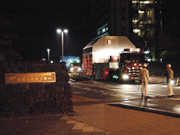
Dec. 26, 2008 Updated
HTV open to the press
|
On Dec. 25, 2008, JAXA revealed the maiden H-II Transfer Vehicle (HTV), an unmanned supply transfer vehicle that will fly to the International Space Station (ISS), to the press at the Tsukuba Space Center (TKSC.) It was the first press conference since assembling all the modules of the first HTV. |
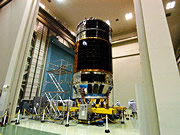 |
|---|
Dec. 18, 2008 Updated
All flight modules assembled for first time for inaugural HTV flight
|
On Dec. 12, all the parts of the H-II Transfer Vehicle (HTV,) the supply transfer vehicle to the International Space Station, were assembled for an all-vehicle functional test ahead of its first flight. They are the "Logistic Carrier Pressurized Section," the cargo section of the "Un-pressurized Carrier," the "Exposed Pallet," the "Avionics Module" and the "Propellant Module." This was the first time that all the modules were assembled. The size of the assembled HTV was about the same size as the Pressurized Module of the Japanese Experiment Module "Kibo." The HTV will be the largest payload that JAXA has ever launched. |
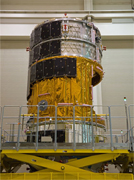 |
|---|
Aug. 28, 2008 Updated
Thermal Vacuum Test for first flight of HTV
|
A thermal vacuum test on the first flight vehicle of the H-II Transfer Vehicle (HTV) has been carried out at the Spacecraft Integration and Test Building at the Tsukuba Space Center. |
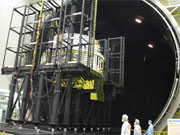 |
|---|
Apr. 18, 2008 Updated
The first model HTV (Technology Demonstration Model) was shown to the press
|
On April 17, 2008, a press review was held for the first model H-II Transfer Vehicle (HTV) (Technology Demonstration Model), which is an unmanned cargo transfer spacecraft to the International Space Station. On display separately were the Pressurized Logistics Carrier for supply transportation, the Avionics Module for vehicle body control and the Propulsion Module which carries the propulsion system. When the HTV is completed and fully equipped, it will be the largest spacecraft in Japan with a length of 10 meters and a weight of 16.5 tons. After going through performance tests like the Thermal Vacuum Test and Acoustic Test, the first model HTV is scheduled for launch from Tanegashima on the H-IIB Launch Vehicle No. 1 (Test Model) in the summer of 2009. |
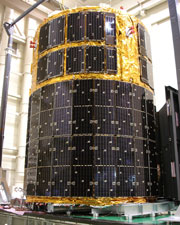 |
|---|
Jul. 2, 2007 Updated
Proximity Communication System (PROX) undergoes testing
|
Tests are currently being performed on the Proximity Communication System (PROX) at NASA's Kennedy Space Center (KSC). |
 |
|---|
Jun. 26, 2006 Updated
Prototype HTV unveiled to press at Tsukuba Space Center
|
On June 23, a prototype of the H-II Transfer Vehicle (HTV) was unveiled to the press at the Tsukuba Space Center (TKSC.) The HTV is an unmanned orbital carrier to the International Space Station (ISS.) It is equipped with both the function of a "manned cargo carrier" for ISS crews to actually embark and carry out supportive work on it and the function of an "inter-orbital carrier" to perform "inter-orbit transportation to a selected attitude," "rendezvous flights to the ISS," and "re-entry" to aim to acquire the necessary technology for autonomous activities in space.
|
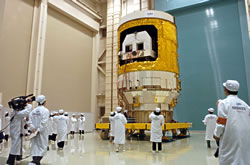 |
|---|
May 28, 2004 Updated
Debris protection function was verified by shooting aluminum balls at the HTV at 6 km per second.
|
Each module of the Space Station including the Japan Experiment Module has a "debris bumper" for protecting itself from losing its functions by colliding with space debris. |
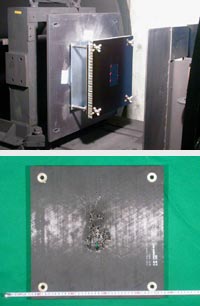 |
|---|
Mar. 28, 2003 Updated
Manufacturing "Thermal Structural Test Models " for Tests in the Next Fiscal Year
|
HTV is about four meters in diameter and a bit shorter than 10 meters in length. In other words, its size can be explained as a container that could accommodate a sightseeing bus. In the process of developing HTV, therefore, it is divided into four modules namely Logistic Carrier Pressurized section, Logistic Carrier Un-Pressurized section, Avionics module, and Propulsion module. Thermal structural test models are being manufactured for each module. A thermal structural test model is a mimic model to test it in simulated harsh launch and space environments for checking acoustic condition, vibration, shock at separation and endurance in the space. |
 |
|---|
Oct. 5, 2001 Updated
|
After HTV's arrival to International Space Station (ISS), Exposed Pallet is taken out of HTV, and cargoes are replaced by robotic arm. This Exposed Pallet has rollers on its sides to minimize the friction and to keep the position accurately when it is brought back to HTV. |
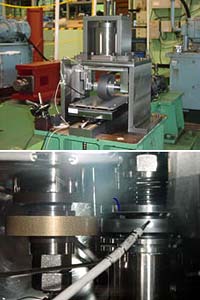 |
|---|
Jun. 29, 2001 Updated
|
Post Development Review of HTV Pressurized Carrier Aft Dome |
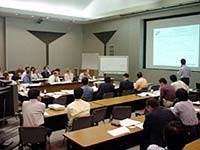 |
|---|
Feb. 19, 2001 Updated
|
Post Development Review of HTV Pressurized Carrier Aft Dome A pressurized carrier equipped in HTV was designed based on the JEM Experiment Logistics Module Pressurized Section (ELM-PS). NASDA determined to use a newly designed integral molded structure for the Aft Dome of pressurized carrier to reduce the weight of 260 kg and the similar structure has already been used by the propellant tanks of Launch vehicles. Similar to H-IIA rocket, MAN-Technologie in Germany took the charge of the development under the supervision of Mitsubishi Heavy Industries LTD. Through this development, MAN-Technologie cleared the manufacturing problems such as thickness, welding, strength, etc., and completed them successfully. The photo shows a manufacturing sample that will be used for following engineering tests in Japan. After this review, NASDA will start manufacturing of the Flight Model and mass production. |
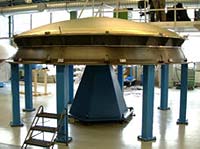 |
|---|
Dec. 8, 2000 Updated
|
Succeeding to the previous tests conducted from April 18 to 20, 2000, NASDA/NASA/CSA conducted a series of real-time HTV capturing operation tests with expanded SSRMS conditions, evaluators, and facility by following schedule. |
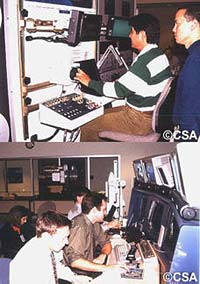 |
|---|
Nov. 9, 2000 Updated
|
When crew enters HTV pressurized carrier berthed to ISS, it is necessary to circulate atmosphere in pressured cabin. The fan system for air circulation should meet several requirements such as large flow rate, low noise, lightweight, compact size, and high durability for severe environment during launch. Because each HTV mission period is relatively short, NASDA plans to develop a new air circulation fan system that is appropriate to HTV requirements. |
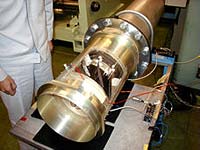 |
|---|
Oct. 6, 2000 Updated
|
The Pre-Shipping Review (PSR) for 28 R-1E thrusters, that will be used for HTV attitude control was held by Primex Space Systems Co. in the United States. These thrusters will be delivered to Ishikawajima-Harima Heavy Industries Co. Then after used in System Firing Test (SFT) in which NASDA confirms the Propulsion-system performance, they will be installed to the first HTV. |
 |
|---|
Jul. 7, 2000 Updated
|
HTV has two carrier sections, one is a pressurized section which carries the logistics to ISS pressurized section and another is an un-pressurized section which carries experiment devices in ISS exposed section. The exposed experiment devices will be taken out from un-pressurized section with exposed pallet by ISS manipulator (SSRMS). |
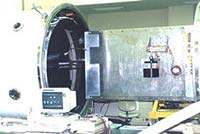 |
|---|
May 26, 2000 Updated
|
HTV will perform autonomous rendezvous flight to the ISS, however, in the final operation, HTV will be captured by ISS manipulator system (SSRMS) controlled by ISS crew and be berthed to the ISS. Such operation is a peculiar requirement for HTV and we must confirm that it can be certainly captured by ISS crew within the limited time. |
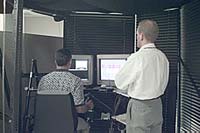 |
|---|
Apr. 21, 2000 Updated
|
In this month, NASA held the following safety review panel toconfirm the HTV safeness regarding to the International Space Station. |
 |
|---|
Jan. 31, 2000 Updated
|
PDR (Preliminary Design Review) for SIGI (Space Integrated GPSR/IMU) which is most important sensor of HTV Guidance and Navigation System was conducted at Honeywell co. in Tampa, Florida in United States from Dec. 9 to 10. |
Dec. 17, 1999 Updated
|
PDR (Preliminary Design Review) for Rendezvous Sensor which to be used during the HTV final approach was conducted at Daimler Chrysler Jena-Optronik in Jena, Germany from Nov.15 to 18. This sensor will also be used for ATV(Autonomous Transfer Vehicle) being developed by ESA. |
Nov. 19, 1999 Updated
|
NASDA conducted the Approach/Release (Rendezvous) Flight Technology Test on the ETS-VII, which has close relation to the HTV rendezvous technology from Oct. 26 to 27. |
Sep. 17, 1999 Updated
|
NASDA held two major review meetings. One was the HTV Phase 1 Safety Review, which examined the HTV design from the point of safety. The another was HTV Preliminary Design Review (PDR), which examined the HTV design from the point of technique. |
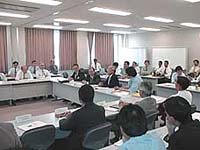 |
|---|
Jul. 26, 1999 Updated
|
The documents for PDR (Preliminary Design Review), which will be conducted from July 15th to September 3rd have been released. These documents have also been sent to NASA, CSA, and ESA in the end of June. |
 |
|---|
